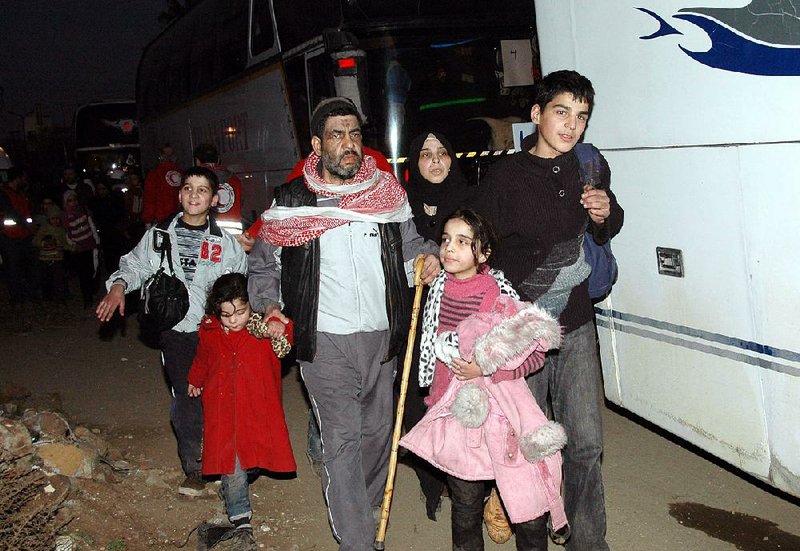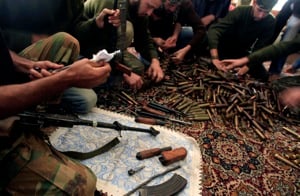BEIRUT - Aid officials rushed Monday to evacuate more women, children and elderly people from rebel-held areas that have been blockaded by government troops for more than a year in Syria’s third-largest city, Homs, after a United Nations-brokered cease-fire in the city was renewed for three more days.
The truce, which began Friday, has been shaken by continued shelling and shooting that prevented some residents from escaping and limited the amount of food aid officials have been able to deliver into the besieged neighborhoods.
U.N. humanitarian chief Valerie Amos sharply criticized the two sides, saying U.N. and Syrian Red Crescent workers were “deliberately targeted.”
The operation in Homs played out as activists reported new sectarian killings in Syria’s civil war.
The violence further rattled peace talks that entered their second round Monday in Geneva - and that quickly became mired in recriminations between President Bashar Assad’s government and the opposition in exile.
The two sides’ first faceto-face meetings adjourned 10 days ago, having achieved little. This time, the two appeared even further apart, with no immediate plans to even sit at the same table. U.N.-Arab League envoy Lakhdar Brahimi was holding separate talks with each side.
“The negotiations cannot continue while the regime is stepping up its violence against the Syrian people,” opposition spokesman Louay Safi said after talks with Brahimi. The opposition insists the talks’ aim is to agree on a transitional governing body that would replace Assad.
But Syrian Deputy Foreign Minister Faisal Mekdad said the issue of Assad stepping down was not on the agenda.
“Please tell those who dream of wasting our time here in such a discussion to stop it,” he told a reporter.
The events of the past few days have underscored each side’s position. The government says it is trying to defeat an extremist, al-Qaida-style insurgency. Syria’s opposition, in turn, points to government blockades of dozens of rebel-held areas that have caused widespread hunger and sickness among civilians as proof of the cruelty of Assad’s rule.
The aid operation in Homs laid bare the desperation in the besieged areas. Homs, in central Syria, was one of the first cities to rise up against Assad, and while government forces have retaken much of the city, several rebel-held districts in its historical old center have been under siege for more than a year.
On Monday, Russia moved to block Western efforts to push through a Security Council resolution that would raise the prospect of sanctions against Syria unless the government allows unrestricted access to deliver humanitarian aid.
Russia’s U.N. Ambassador Vitaly Churkin vowed to veto the proposed measure if necessary. Both he and China’s U.N. ambassador were no-shows at a meeting Monday to discuss the resolution.
Churkin dismissed the resolution as a “political” measure introduced “to whip up political tensions around Syria.”
Many of those evacuated from Homs since Friday “were traumatized and weak,” Amos said in a statement. They reported “terrible conditions at the field hospital in the Old City, where the equipment is basic, there are no medicines and people are in urgent need of medical attention.”
She said about 800 had been evacuated since Friday, although the governor of Homs province put the number around 1,070, including 460 evacuated Monday. Under the truce, the government refused to allow men between the ages of 15 and 55to leave, presuming them to be fighters.
Amos said the truce had been extended for three days. The original truce ran from Friday to Sunday but that the continued shelling and shooting between the two sides severely limited efforts. Eleven people were killed by the fighting.
Over the weekend, some women and elderly people tried to leave but couldn’t make their way through checkpoints to evacuation buses, according to Khaled Erksoussi, the head of operations of the Syrian Red Crescent.
He said some food aid was brought into the areas over the weekend - “but not the quantity we had hoped for” - and none made it in Monday.
The sectarian killings Sunday were in the village of Maan, north of the central city of Hama. Hard-line Islamic fighters overran it Sunday after mortars from the villagehit rebels on a nearby road, said Rami Abdurrahman of the British-based Syrian Observatory for Human Rights.
At least 25 of the victims were civilians, including an extended family of 11 - a man, his wife, and their sons and daughters - along with eight other women and six men, Abdurrahman said. Another 20 killed were village fighters defending their homes, he said. The ages of the civilians were not known. He said he obtained details on the killings from residents of nearby villages.
The villagers are predominantly Alawites, a Shiite offshoot sect to which Assad belongs and that is a pillar of support for his rule.
The rebels who overran the village belonged to two hard-line factions, Jund al-Aqsa and Ahrar al-Sham.
Information for this article was contributed by Bassem Mroue and Edith M. Lederer of The Associated Press.
Front Section, Pages 5 on 02/11/2014

